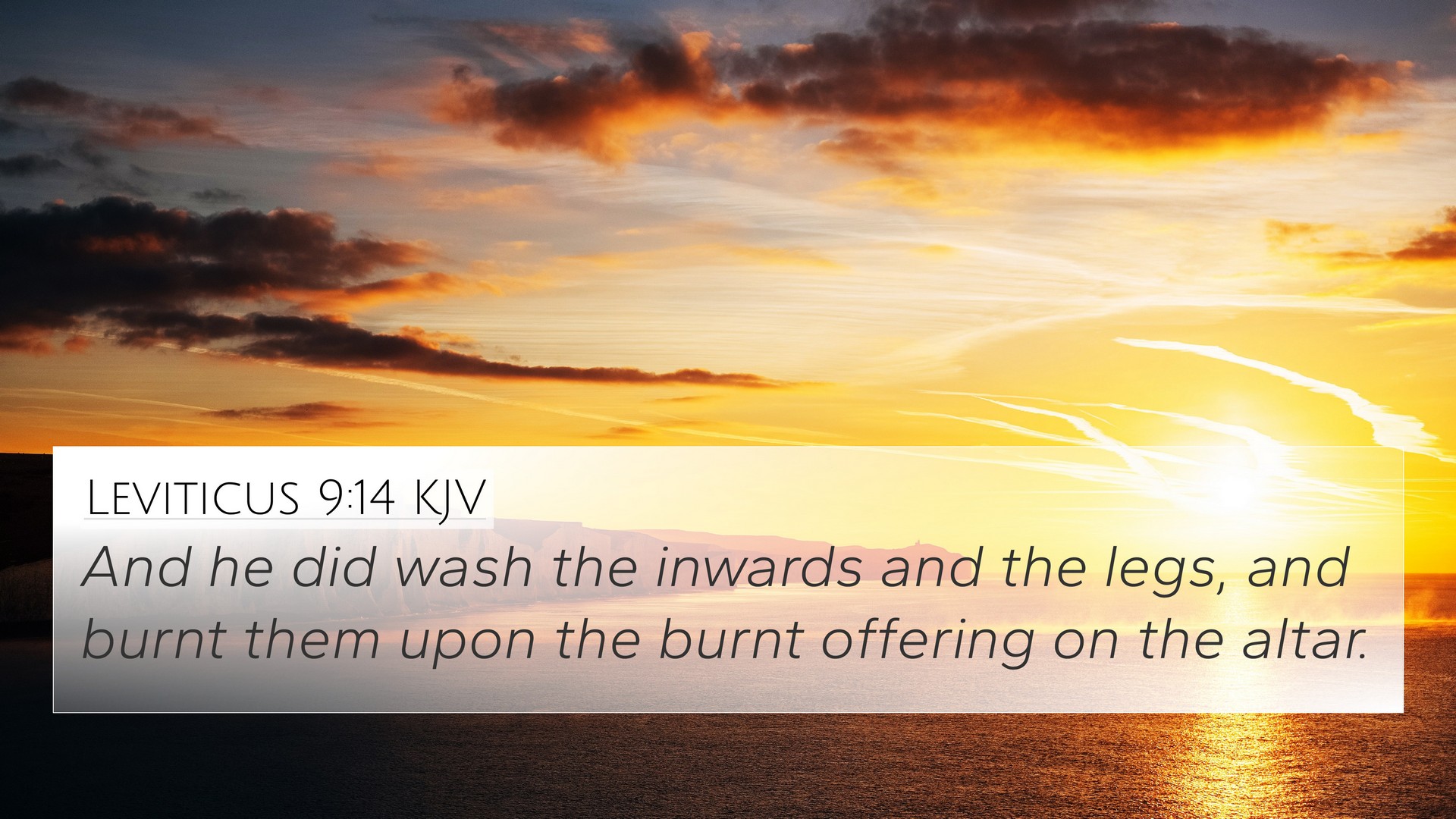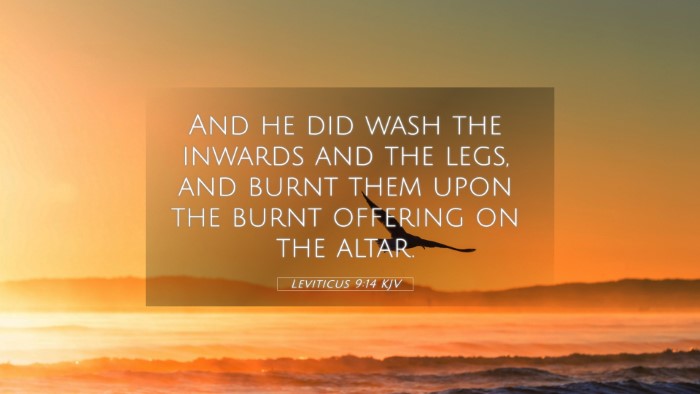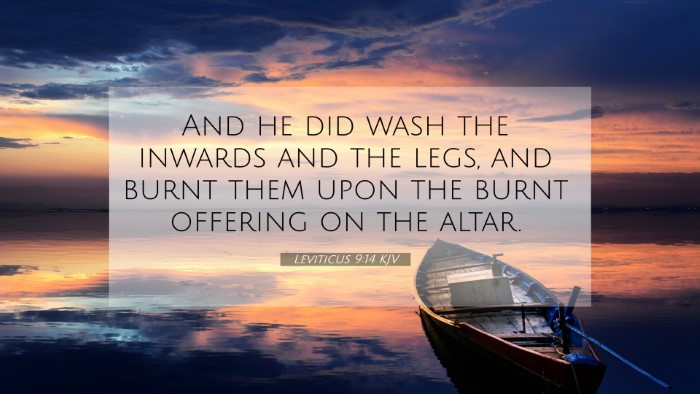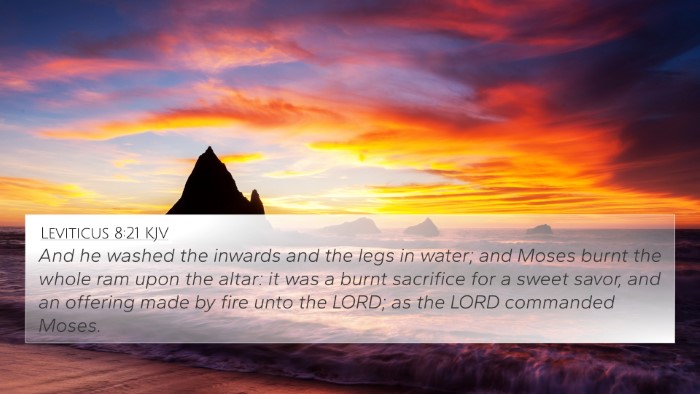Meaning and Interpretation of Leviticus 9:14
Leviticus 9:14 states: "And he washed the entrails and the legs, and burned them upon the burnt offering on the altar." This verse is part of the account of the initial offerings made by Aaron and the priests on the day they were consecrated to serve in the tabernacle.
Summary of Insights
The verse is significant for various reasons, primarily illustrating the meticulous nature of the sacrifices mandated in the Law of Moses. Public domain commentaries emphasize several key themes:
- Symbolism of Purification: The washing of the entrails and legs signifies purification, an essential theme in sacrificial rituals. Matthew Henry notes that washing represents the cleansing that is necessary before approaching God.
- Acceptance of Offerings: Adam Clarke highlights that the act of burning the washed portions upon the altar was an acknowledgment of the acceptance of the offering by God, illustrating divine approval of worship done in obedience.
- Role of the Priesthood: Albert Barnes points out the crucial role of priests in performing these rituals. Their actions demonstrate the need for an intermediary between humanity and the divine, reflecting the broader theme of mediatorship in scripture.
- Foreshadowing of Christ: These rituals can also be seen as foreshadows of Christ’s ultimate sacrifice, wherein He fulfills and transcends the Old Testament sacrificial system.
Understanding through Cross-References
To fully grasp the implications of Leviticus 9:14, it is helpful to consider cross-references that illustrate its theological significance:
- Exodus 29:22-25: This passage discusses the portions of the sacrifices specifically designated for the priests.
- Leviticus 1:9: The process of offerings to the Lord is elucidated, providing context to the importance of cleanliness and separation unto God.
- Hebrews 9:22: The necessity of blood for the forgiveness of sins is a direct correlation to the sacrificial system initiated in Leviticus.
- Romans 12:1: The call to offer ourselves as living sacrifices can trace its roots to the principles of sacrifice laid out in Leviticus.
- 1 Peter 2:5: Reflects the believer's role as a priest, aligning with the themes of dedication found in the Levitical code.
- John 1:29: John the Baptist identifies Jesus as the Lamb of God, connecting the sacrificial nature of offerings to the New Covenant.
- Isaiah 53:5: Prophecies concerning the atonement provided through sacrificial suffering find roots in the rituals established in Leviticus.
- Ephesians 5:2: The idea of Christ's self-sacrifice is a clear parallel to the offerings discussed throughout Leviticus.
- Matthew 5:23-24: The call for relationships to be reconciled before offering speaks to the heart behind the rituals of sacrifice.
- 1 Corinthians 5:7: Relating the Passover lamb to Christ, encapsulates the transitional nature of sacrificial symbols from the Old to the New Testament.
Practical Insights for Study
Engaging deeply with Leviticus 9:14 encourages a thorough exploration of the broader themes present throughout the Bible. Here are practical ways to enhance your study:
- How to use Bible cross-references: Begin with Leviticus 9:14 and explore the suggested cross-references for a holistic understanding.
- Bible concordance: Utilize a concordance to find terms and themes that repeat throughout the scriptures.
- Bible cross-reference guide: Consider using a resource that lists related verses along thematic lines for deeper connections.
- Cross-reference Bible study: Pair passages from Leviticus with New Testament scripture for a comparative analysis of themes.
- Bible chain references: Create a chain of related scriptures to visualize the connections across both Testaments.
- Cross-referenced themes in the Bible: Document the themes uncovered in Leviticus and how they resonate throughout the Bible’s narrative.
- Comparative study of Pauline epistles: Especially look for how Paul addresses sacrificial concepts in light of Levitical law.
Conclusion
Leviticus 9:14, while a singular verse within the ceremonial code, opens up a rich dialogue across the scriptures. By utilizing tools for cross-referencing and identifying inter-Biblical connections, one can gain profound insights into the nature of God’s requirements for holiness, the role of sacrifice, and the ultimate fulfillment found in Christ.



